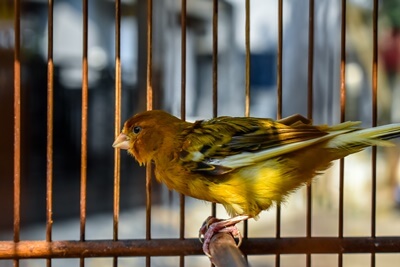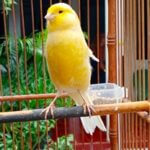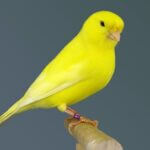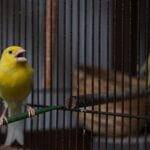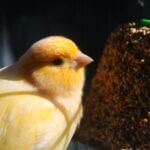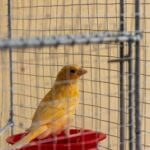Canaries handle stress poorly. They’re easy to scare and may remain frightened long-term if the stressor isn’t removed from their environment and steps aren’t taken to calm them down.
Unfortunately, canaries can’t communicate their discomfort in as many overt ways as other animals. So, the signs of fear in canaries are often subtle or easily mistaken for something else.
Do Canaries Get Scared?
Canaries are small prey animals with many predators. Their main line of defense is their fast reaction time, so remaining alert and on-guard is a way for canaries to recognize and flee danger.
Consequently, canaries are often considered skittish animals. They can react adversely to having someone reach into their cage, even if the person is familiar to them and means no harm.
What Are Canaries Scared of?
Knowing what scares a canary and what causes these fears enables you to avoid stressors in the future. Here are some of the things that can produce an adverse reaction:
Unfamiliar Environments
Most birds are frightened by new environments and require time to settle down. However, canaries are especially skittish in new places because they’re not social animals.
They rarely take comfort in the close presence of their own kind, or other types of birds, so they’ll rarely have a companion to transition through a stressful situation.
When you introduce a new canary into your home, the chances are that it’ll be nervous and on edge. Unfortunately, their fearful behavior may last for several weeks.
The reaction may be less severe if you move the canary to a new cage or room in your home. It may calm down within days but be unsettled and upset until then.
So, give your new canary time to settle in and become comfortable before establishing a routine.
Other Birds
Predatory birds prey on canaries, such as hawks, eagles, and falcons. Consequently, seeing one of these birds flying near your home or being perched in your yard might trigger a fear-based response. So, keep your canary away from windows and never place its unsupervised cage outside.
Occasionally, placing a canary in a room with another large pet bird can startle it. The appearance of a large parrot, especially if it’s loud, can unsettle your canary and make it believe it’s in danger. Consequently, housing canaries with other birds is actively discouraged.
Household Pets
Canaries are naturally distrustful of other animals, especially large ones. The more predator-like the animal behaves, or the louder it is, the more frightened a canary will be.
A cat that sits nearby and stares at a canary may scare it deeply, and a big dog will be startling, especially if it starts to bark loudly. Smaller pets can be upsetting to canaries, especially if they move quickly or approach the cage bars.
Even if your other pet means no harm and would never attack the canary, the mere presence can be terrifying for canaries. So, don’t let them interact. Some canaries may eventually learn to be comfortable around other pets, especially from a distance, while others will never relax.
Loud Noises
Canaries are hypervigilant about any inexplicable environmental changes, which is the case regarding auditory stimuli.
Sudden loud noises, such as banging doors, shouting, and vehicle noises, can startle canaries. In the wild, sudden and intense noises indicate danger, so the canary will react accordingly.
Unfamiliar People
Canaries don’t adapt quickly to relationships with humans. So, while your canary may grow to trust you, it may feel unsettled by another person.
Even if your canary likes to sing with you or perch on your finger, being approached by a new human, especially if the person attempts to handle them, may lead to a panic response.
New Items in Their Cages
At times, canaries will get scared by new items in their cage, even if they’re meant to serve as enrichment. A canary may avoid perches, swings, bells, or other toys for days when they’re newly added.
It takes time for a canary to realize a new toy is normal and harmless. While some adapt rather quickly, especially if you add new toys often, others may be slow to trust.

What Do Canaries Do When They Are Scared?
According to the Society for Endocrinology, exposure to stressful events in early life can affect how a bird reacts to stress in adulthood.
So, being aware of how your canary behaves when scared provides insights into its developmental history, enabling you to devise strategies to make your pet canary feel safer.
Physical and behavioral signs your canary might exhibit it is scared include:
1/ Crouching
A crouched position indicates that the canary is preparing to take flight. Sometimes, the crouching stance is accompanied by flattening feathers, trembling, or flapping wings.
2/ Biting or Lunging
A canary that feels threatened might resort to aggressive behaviors, such as biting or lunging at the perceived threat. This could be paired with flapping wings, puffed feathers, and other actions that make the canary seem larger or intimidating.
3/ Screaming And Screeching
Canaries aren’t prone to screaming and rarely (if ever) screech.
If a canary is threatened, it might scream or screech loudly as a response to panic and fear for its life. This can also be a last-ditch effort to scare away a predator.
4/ Reduced Vocalization
While some canaries react to threats with loud vocalizations, others respond by quieting down and making as few vocalizations as possible. This is an attempt at hiding and avoiding notice by a predator.
If your canary isn’t singing, check whether something in its environment has frightened it. The canary may not vocalize again until it feels safe.
5/ Lack of Appetite
Being scared is an exhausting ordeal, especially if that stress continues long-term.
Canaries may have a reduced appetite when anxious or fearful. They may be so frightened that they don’t want to move toward the food bowl and expose themselves to the danger.
Even the process of eating is a vulnerable position, as the canary can’t watch for threats with its head down. So, it may avoid eating entirely.
6/ Feather-Plucking and Self-Mutilation
If a canary is scared or placed under constant stress from a threat, it may feel helpless and unable to cope. In response, it may pull out feathers or engage in self-destructive behaviors, like biting its skin.
7/ Lethargy or Inactivity
A canary may become lethargic or tired when scared. It’ll be exhausted by the constant stress, and be too fearful to move, fly, hop, climb, or engage in activities that draw attention to it.
When this happens, the canary might isolate itself in a corner inside its cage, which can be a means of hiding and avoiding any contact or interaction.
Can Canaries Die from Being Scared?
Unlike some birds, canaries rarely die from stress, and a canary is unlikely to be scared to death or have a heart attack due to sudden fright.
However, if a canary is chased around or exposed to severe, long-term stress, it can die of exhaustion.
Exposure to frightening situations for an extended period compromises its immune system, making it susceptible to illness and disease, leading to a shortened lifespan.
Why Is My Canary Scared of Me?
Canaries can develop strong bonds with their owners after spending lots of time together. Once your canary becomes comfortable in your presence and learns to trust you, it’ll enjoy your attention.
So, it’s sad when your canary becomes frightened of you or continues to act skittish around you after owning it for many months. In these situations, there are two possible causes:
- The canary is so frightened by something else that it’s reacting fearfully around you.
- You’ve done something wrong, so the canary has grown distrustful of you.
Check for loud noises, flashing lights, other pets, and factors that could upset your canary. It’s also possible that the canary is ill and wants to isolate itself away from you as a means of protection.
Alternatively, you may have incorrectly handled the canary or upset it when cleaning the cage. If the canary felt mistreated or was accidentally harmed by you, it’ll respond with fear.
Raising your voice or acting aggressively near the canary’s cage can lead to avoidance.
How To Calm A Scared Canary
Calming your canary when it’s fearful is important for limiting its stress, preventing it from injuring itself, and strengthening its trust in you. You can attempt this by:
- Removing the stressor, whether that’s turning down a loud TV, removing a barking dog, or moving the cage away from a window with flashing car lights.
- Covering its cage and introducing darkness so it’s not exposed to visual or audio stressors.
- Providing treats or rewards (avoid hand-feeding, as a frightened canary will be further stressed by a hand in its cage).
- Playing calming music, preferably songs your canary likes.
- Playing other canary songs at a low volume, so it has a distraction.
You can avoid invoking a fear-based response in a canary by changing how you approach it:
- Introducing new toys and accessories gradually.
- Allowing the canary to see and play in a new cage before a permanent move.
- Visiting a room several times over a couple of weeks before being moved there.
- Spending time around a canary before attempting to handle it.
These simple adjustments can calm down your canary.

